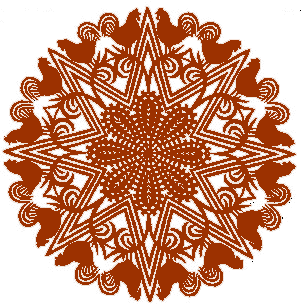
Wycinanki - 1957
The following passages, taken from the introduction by Dr. Tadeusz Delimat to Irena Czerniecka's book "Folk Art in Poland" published in Warsaw in 1957, provide an insight to the policies and posture of the communist regime of "People's Poland" in the area of the folk arts.|
|
In Poland, like in other European and overseas countries, culture unfolded along two separate but interpenetrating paths: professional and folk art. Professional culture, developing on the basis of writing, reflected the needs of the privileged social classes. Folk culture, particularly that aspect of it which interests us most —- folk art based on illiteracy and practiced above all by the peasantry — lived in the shadow of professional culture and evoked within bounds set by the more or less limited means at its disposal
*
A flourishing art form in certain areas or the country and a precious element in the interior decoration of village dwellings is the cut-out pasted on walls and ceiling. It appears in two basic. forms: as a single openwork cut-out reaching top level, chiefly in the Kurpie region, and a combined cut-out, composed of various elements stuck one atop the other, in layers, most characteristic of the Lowiez region. The combined Lowicz cut-out of an earlier period continues to use Renaissance, stylized plant motifs or realistic patterns; those of more recent vintage depict contemporary scenes.
*
Bold perspectives have been opened up in People’s Poland for the development of folk art. Due to its unquestionable value it has been placed on the same level as professional art and is given all possible opportunities to participate in the new development of our national culture. The People’s Government, in assigning to folk art this important role, manifests concern for its welfare. This concern is real and tangible. Large funds are allotted for research on folk art and for popular publications based on these findings (Polish Folk Art, Atlas of Polish Folk Costumes). There has been a substantial growth in the number of museums and branches whose task it is to collect and popularize folk art relics. Assistance is given to the folk artist through the organization of exhibits and contests, through the awarding of medals, prizes and stipends, through the convening of conferences and meetings and the bringing together of folk artists and art school graduates. It is constantly being emphasized that folk art is a source from which all professional artists and cultural workers can draw their inspiration, just as our greatest artists have done in the past.
These activities have already given results. Not only has folk art remained alive but it also shows marked development. In some fields it has assumed a much richer form than had ever been recorded in history. Decorative textiles, embroidery, laces and artistic ceramics are flourishing. Wood carving comes forth steadily with new and bold ideas. Ever more numerous are the song and dance ensembles who popularize at home and abroad the charm of Polish folk costumes. Folk art, too, is being used more arid more in the interior decoration of institutions, offices and clubrooms, as well as applied to manufactured articles. The folk artist, long anonymous, has become a personality, recognized and respected as a contributor to the entire cultural upsurge whose aim is the return to the best and truly national traditions.
The Folk Arts of Poland Gallery in Santa Fe, NM, one of the principals of which has spent 20 months in Poland since 1993 reaserching folk arts, had posted on its website a page entitled Historical Perspective (currently not displayed). It contained the following statement regarding Poland's communist government's support of Folk Arts.
During the 1950s, folk art foundations were established and financially supported by the government. After acceptance into one of the folk art associations, the artists, folklorists, poets, and writers received a monthly wage and social benefits. Museums were allotted vast sums of money to purchase from these members. After the fall of socialism in the 1990s, most of the benefits and museum purchases were drastically reduced, forcing two thousand registered association members to support themselves as private entrepreneurs. Some members have successfully made the transition to the market economy but many, however, have not.
| Info-Poland a clearinghouse of information about Poland, Polish Universities, Polish Studies, etc. |
